Regional Cuisines in China
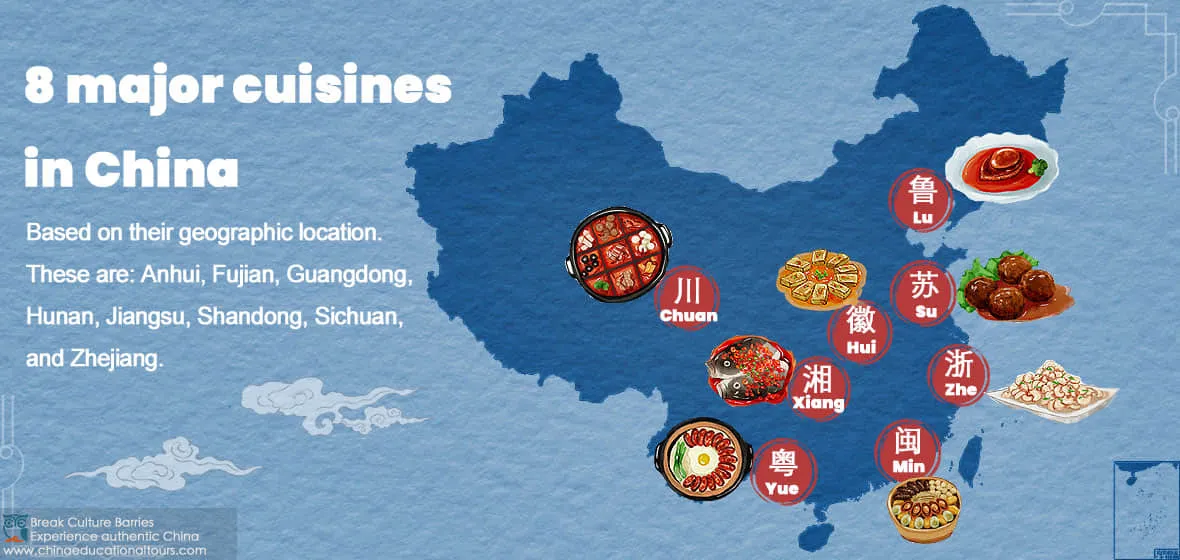
When someone asks you, "Do you like Chinese food?" you may find that this difficult to answer, because "Chinese food" means different things to different people, with so many regional variations in Chinese cuisine. Essentially, there are 8 major regional cuisines, based on their geographic location. These are: Anhui, Fujian, Guangdong, Hunan, Jiangsu, Shandong, Sichuan, and Zhejiang. Naturally, they are strongly influenced by the local terrain, the people, and the staple crops that grow in each region. (Some people, however, only make a distinction between four styles – Cantonese, Haiyang, Shandong, and Sichuan cuisine.)
In general terms, both Sichuan and Hunan cuisines are hot and spicy, Anhui and Fujian cuisines include wild foods from the mountains in those regions, the flavors in Guangdong (Cantonese), Fujian, Zhejiang, and Jiangsu cuisine are all generally light and sweet, including a lot of seafood in the cuisine, and Shandong cuisine is fresh and salty and also includes a lot of seafood.
1. Guangdong Cuisine – Cantonese (Yue Cai 粤菜)
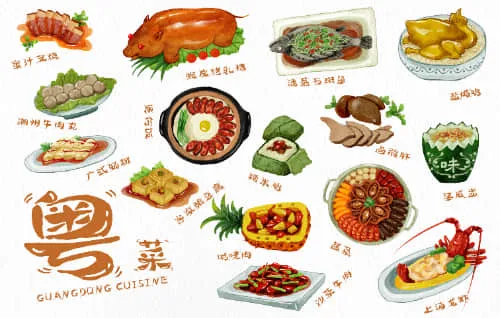
This is what most foreigners tend to mean by "Chinese food", because this is the style of cuisine most commonly served overseas in Chinese restaurants. Guangdong Province and Hong Kong are noted for fine seafood dishes and rice dishes. They offer a wide variety of foods, and the dishes they serve have lightly seasoned flavors, not too strong, and often tend to be a little sweet. Influenced by both Oriental and Western cooking traditions, the favored cooking styles are braising, stewing and sautéing and typical ingredients include a variety of meats (including possibly snake, cat, anteater etc.) and the vegetables are mostly seasoned with sugar and spiced salt. Popular sauces include Hoisin Sauce, Oyster Sauce, Plum Sauce, and Sweet and Sour Sauce.
Recommended: Dim sum is available everywhere (all over the world), but Cantonese dim sum ranks the best in the whole country, so make sure you try it. Worth including in your dim sum meal are Hong Kong egg custard tarts, wontons, and spring rolls.
The most famous dish is Roast Suckling Pig (Kao Ru Zhu). Other classics to look out for are Roast goose (shao e), Shark's Fin Soup (Yuchi geng), Salt and Pepper Snake (Jiayan dawang xia), Steamed Turtle with Chives (Qingzeng jiayu), and 'The Dragon and Tiger Fight'.
2. Anhui Cuisine (Hui Cai 徽菜)
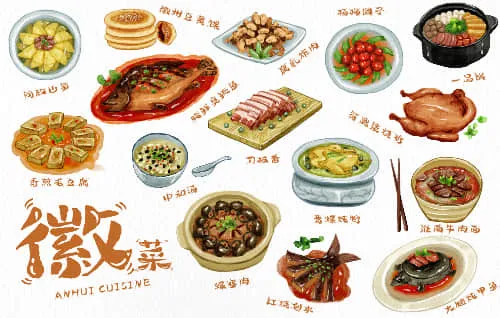
Also known as Hui Cuisine, Anhui Cuisine is well known for including wild foods from the mountains, both plants and animals, with a healthy emphasis on ultra-fresh ingredients. With fresh herbs, mushrooms, berries, tea leaves, bamboo shoots and other regional plants, it presents as visually interesting with simple flavors.
The cooking methods include braising and stewing and using a lot of oil, with special attention given to the appearance, color, taste and temperature of the food in order to preserve the nutrients in the food.
Recommended: Best known dishes include 'Stewed Soft-shelled Turtle in Clear Soup', 'Bamboo Shoots with Sausage', Dried Mushrooms, and Stinky Tofu. Other classics to look out for are Yellow mountain stewed pigeon (Huangshan dun ji), Crisp pork with pine nuts (Songren paigu), Anhui-style smoked duck (Wuwei xun ya), and Red-braised fish tails (Hongshao huashi).
3. Fujian Cuisine (Min Cai 闽菜)
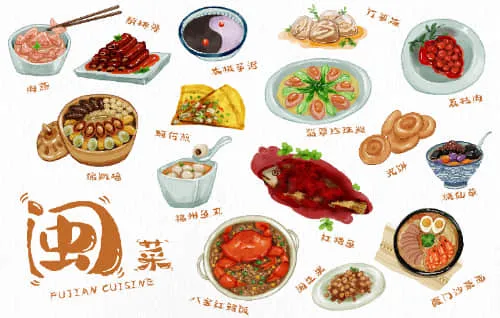
Fujian Cuisine, also known as Min Cuisine, is characterized by wild foods from the mountains, great seafood, and generally sweet and light flavors. Fujian Province is in southern China, with geographical features reflected in the combination of seafood and woodland-based ingredients. Dishes have a delicate savory flavor, and almost always come with soup.
The texture of the dishes is enhanced by the chef's knife skills, with finely chopped ingredients being quickly boiled, stir-fried, or added to soup. Some of the most nationally popular dishes from the region are also prepared with red wine and referred to as "drunken" dishes. The most commonly used sauce is a Fermented Fish Sauce known locally as Shrimp Oil.
The cuisine category actually consists of four sub-categories: Fuzhou, the lightest taste of the styles, often has a sweet and sour flavor; Western Fujian with a slightly spicier taste from oft-used mustard and pepper; Southern Fujian is spicy and sweet, with an elaborate selection of sauces utilized; Quanzhou is the least oily of the styles but has the strongest flavor and great emphasis is placed on the aesthetic of the dish.
Recommended: Some of the most famous Fujian dishes have wonderful names such as: 'The Monk Jumps Over the Wall', 'Fried Xi Shi's Tongue' and 'Jade Pearl Abalone'. Other 'Min' classics to look out for include Braised shark fin (Hongshao yuchi), Steamed chicken with egg white (Furong jiwan), Crisp pomfret with lychee (lizhi changyu), Oyster pancake (Hao zai jian) and Seven stars fish balls (Qixing yuwan).
4. Hunan Cuisine (Xiang Cai 湘菜)
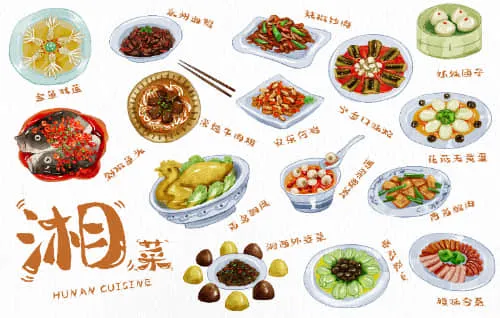
Hunan Cuisine, also known as Xiang Cuisine, is known for rich, moist and creamy dishes which are generally hot and spicy (although it is a "dry" heat, different from Sichuan Cuisine). Located in southern China, Hunan is dominated by rolling hills and beautiful valleys, which provide a fertile ground for growing a wide range of crops, especially rice, and so this cuisine is generally low cost. This cuisine is famous for its spiciness, deep colors and fresh aromas. Smoked and cured foods are typical in this part of the country. The main cooking techniques include braising, stewing, smoking and steaming. The most popular seasonings are soy sauce, tea seed oil, spicy oil, Chinese red pepper, fennel and cassia bark.
Recommended: The most famous Hunan dishes to look out for include 'Dong'an Chicken' (Dong'an ji), 'Chopped Pepper Fish Head', 'Crispy Duck', 'Orange Beef' and 'Spicy Frog's Legs', La zi chicken (lazi jiding), and Smoked pork with pickled beans (Larou suan doujia).
5. Jiangsu Cuisine (Su Cai 苏菜)
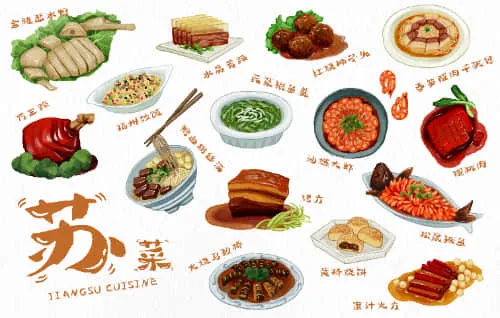
Jiangsu Cuisine, also known simply as Su cuisine, is well known for its great seafood and generally sweet and light flavors, and tender textures, with an emphasis on soup. Most popular cooking methods include stewing, braising, stir-frying and pickling, often with some added sugar. Dishes are often cooked using the earth around them, including slow-baking over an open fire and skillful braising in mud.
More often than not the dishes are carefully arranged to make a visual impact, with emphasis placed on matching shapes, achieved through precise knife work, and serving soup with each meal to enhance the dining experience. Seasonal vegetables include 'water shield' (Brasenia schreberi), lotus, Chinese chestnut, winter bamboo shoots, water bamboo and water chestnuts.
Recommended: Famous examples of typical Jiangsu dishes to look out for include 'Jinling salted dried duck' (Nanjing's most famous dish), crab shell meatballs (pork meatballs in crab shell powder), 'Yangzhou steamed Jerky strips' (dried tofu, chicken, ham and pea leaves), and 'Farewell My Concubine' (soft-shelled turtle).
6. Shandong Cuisine (Lu Cai 鲁菜)
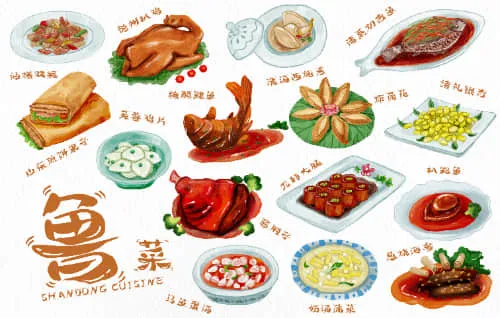
Shandong Cuisine is also known as Lu Cuisine, and is recognized as being fresh and salty, with a lot of seafood dishes. One of the main characteristics of this type of cuisine is the tendency to eat bread instead of rice and the use of onions as a seasoning. The most popular ingredients include seafood such as scallops, prawns, clams, sea cucumbers and squid. Millet, wheat, oat and barley are used to make a variety of delicious breads. Common vegetables include potatoes, tomatoes, cabbages, mushrooms, onions, garlic and eggplants. Roasted or salted peanuts are also often used to add a bit of crunchiness and flavor to dishes. Common methods of preparation are quick-fry and deep-fry, which creates the distinctive crispy texture of the dishes. Typical dishes include lightly seasoned seafood, soups, and stir-fried, braised and deep-fried foods.
Recommended: The most popular Shandong dishes to look for include Dezhou grilled chicken (Deshou paji), Bird's nest in clear soup (Qingtang yanwo geng), Lotus flower and shrimp (Hehua daxia), and Sweet and sour carp (Tangci liyu).
7. Sichuan Cuisine (Chuan Cai 川菜)
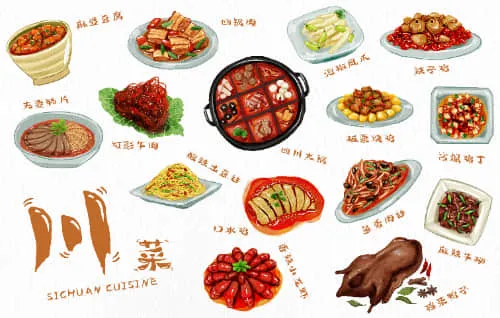
Sichuan Cuisine can also be called Szechuan or Szechwan Cuisine, and is typically a very spicy, flavorful style originating from Chengdu and Chongqing, Sichuan Province in south-western China. This area generally has weather with high humidity and lots of rain, which is why so much Sichuan Pepper and Chili Oil is used as it helps reduce internal dampness. Because of the humidity, a lot of foods are preserved by pickling, salting, drying, and smoking.
Sichuan cuisine is also well-known for its fish dishes and offers more beef dishes than other types of Chinese cuisines, which is said to be due to the abundance of oxen in the region. A variety of different cooking methods are employed, including sautéing, stir-frying without steaming, dry-braising, soaking in water (Pao), or frying and then braising with corn flour sauce (Hui).
Recommended: Some of the most well-known and popular Szechuan dishes to make sure you don't miss are 'Kung Pao chicken' (gongbao jiding), Mapo Tofu (mapo doufu), 'Twice Cooked Pork', 'Tea Smoked Duck', 'Husband and wife lung slices' (fuqi feipian), Dandan noodles (dandan mian), and 'Gluttonous bullfrog' (chanzui niuwa).
8. Zhejiang Cuisine (Zhe Cai 浙菜)
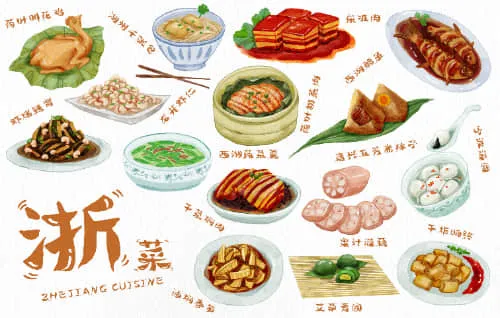
Zhejiang (or Zhe Cuisine) is known for great seafood and generally sweet and light flavors. With a mellow and non-greasy flavor, this cuisine prominently features freshwater fish in its dishes, just as the Jiangsu cuisine does, provided by the Yangtze River. Additional supplementary ingredients are added with the purpose of mellowing out the fishy smell and cutting greasiness.
Nearly half the dishes in this cuisine include bamboo shoots, which adds a tender element. Meat is often marinated in a mixture of vinegar and sugar, and the main methods of cooking are quick frying, stir-frying, braising and deep-frying.
Recommended: The most famous Zhejiang dishes to make sure you try include 'Dongpo Pork' (Dongpo rou), Shrimp Sautéed with Dragonwell Tea Leaves (Lonjin Xiarou), and Beggar's Chicken (Jiaohua ji).

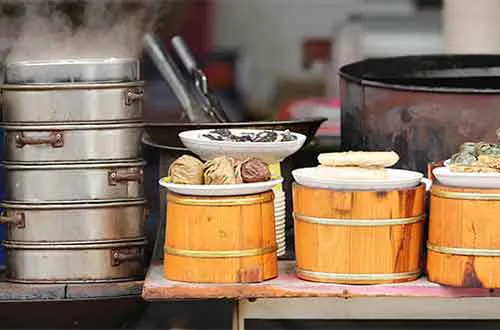 Chinese Cooking Methods
Chinese Cooking Methods 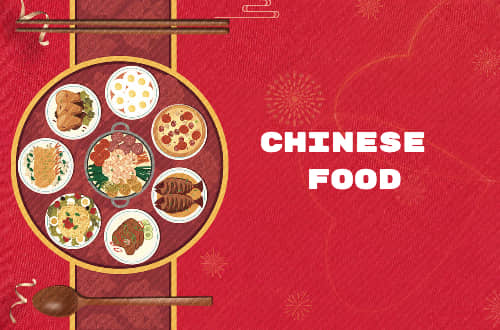 Chinese Food and Related Customs
Chinese Food and Related Customs 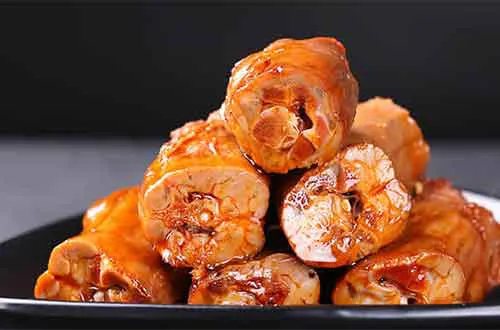 Meats in Chinese Food
Meats in Chinese Food 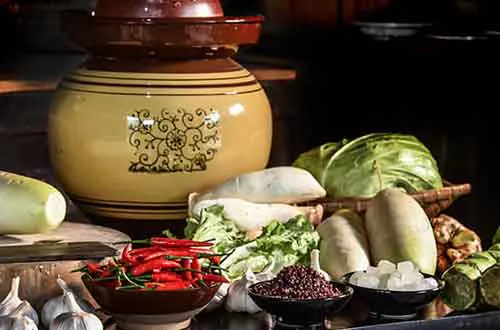 Staples, Tofu and Vegetables
Staples, Tofu and Vegetables